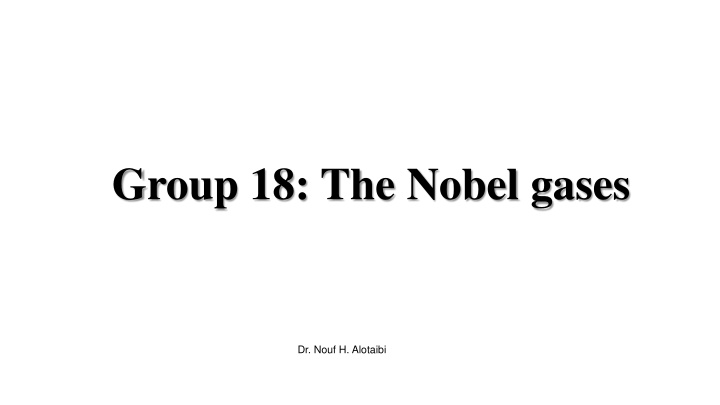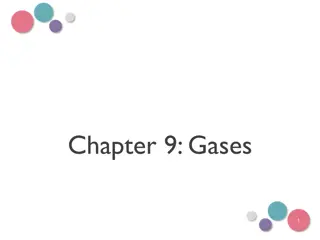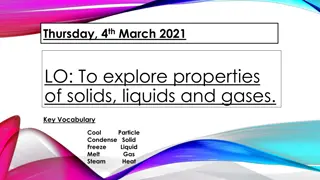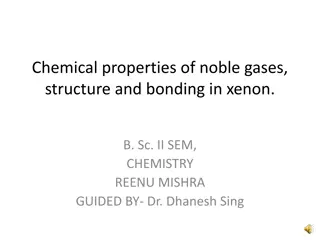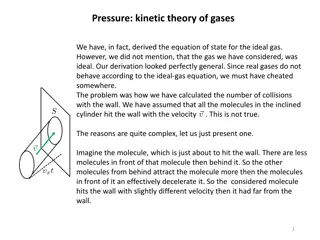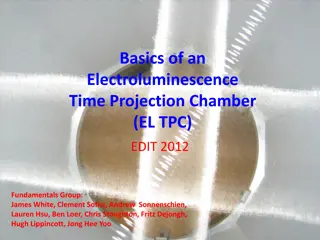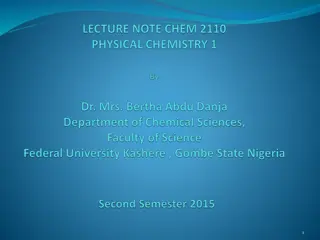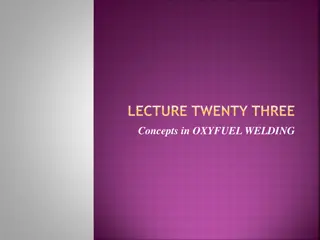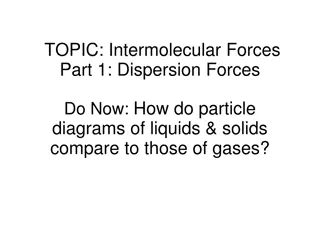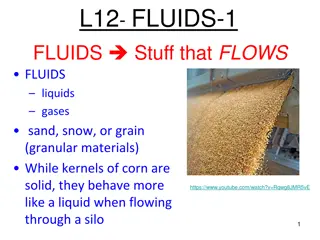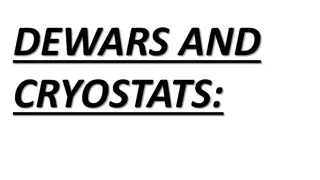The Noble Gases: Properties, Sources, and Uses
The noble gases, including helium, neon, argon, krypton, xenon, radon, and Oganesson, are characterized by their low reactivity due to a complete electron configuration. They have diverse applications, such as forming inert atmospheres, medical treatments, and lighting technologies. Naturally occurring in the atmosphere as monatomic gases, noble gases exhibit unique physical and chemical properties that make them valuable in various industries.
Download Presentation

Please find below an Image/Link to download the presentation.
The content on the website is provided AS IS for your information and personal use only. It may not be sold, licensed, or shared on other websites without obtaining consent from the author.If you encounter any issues during the download, it is possible that the publisher has removed the file from their server.
You are allowed to download the files provided on this website for personal or commercial use, subject to the condition that they are used lawfully. All files are the property of their respective owners.
The content on the website is provided AS IS for your information and personal use only. It may not be sold, licensed, or shared on other websites without obtaining consent from the author.
E N D
Presentation Transcript
Group 18: The Nobel gases Dr. Nouf H. Alotaibi
Group 18: The Nobel gases The Nobel gases The noble gases, also known as the inert gases or rare gases, are located in Group VIII A of the periodic table. Group VIII is sometimes called Group 0. This group is a subset of the nonmetals. The noble gases are; helium (He), neon (Ne), argon (Ar), krypton (Kr), xenon (Xe) , radon (Rn) and Oganesson (Og). The elements have a [core]ns2 np6 electron configuration with a complete octet. (n is the period number) Their closed shell electron configuration makes them have a very low reactivity.
Group 18: The Nobel gases The Nobel gases Noble gases have a full valence shell. The noble gases are the smallest elements in their respective periods, with the highest ionization energies. Noble gases have very low melting and boiling points. Only Kr, Xe, and Rn are known to form compounds. Xe is the most reactive noble gas and exhibits all even oxidation states from +2 to +8. Very low electronegativities No color, odor, or flavor under ordinary conditions Nonflammable At low pressure, they will conduct electricity and fluoresce
Group 18: The Nobel gases The Nobel gases All the noble gases occur in the atmosphere as monatomic gases. They are monatomic, which means they exist as individual atoms. Most other gases are diatomic. Together they make up 1% (by mass) of the atmosphere. Argon is the third most abundant gas in the atmosphere after N and O. Sources of the Noble Gases All of the noble gases except He and Rn are obtained by the fractional distillation of liquid air. The major source of helium is from the cryogenic separation of natural gas. Radon, a radioactive noble gas, is produced from the radioactive decay of heavier elements, including radium, thorium, and uranium. Element 118 (Og) is a man-made radioactive element, produced by striking a target with accelerated particles.
Group 18: The Nobel gases Uses of other noble gases The noble gases are used to form inert atmospheres, to protect specimens, and to prevent chemical reactions (to prevent oxidation). Argon is also used to fill some types of light bulbs, where it conducts heat away from the filament. Krypton gives an intense white light when an electrical current is passed through it and it is used in airports for there runway lights used: In lasers for eye surgery, to stop bleeding on the retina. In lighthouses and other types of lamps. Xenon is used: In various types of electron tubes, lamps, lasers and in high speed photographic flash tubes Radon is used: To treat cancer by radiotherapy, because it is radioactive. However, because radon is radioactive, it is also an environmental hazard.
Group 18: The Nobel gases The Atomic and Physical Properties Atomic mass, boiling point, and atomic radii INCREASE down a group in the periodic table. The first ionization energy DECREASES down a group in the periodic table. The noble gases have the largest ionization energies, reflecting their chemical inertness. INCREASE Down Group 18, atomic radius and interatomic forces resulting in an INCREASED melting point, boiling point, energy of vaporization, and solubility. The INCREASE in density down the group is correlated with the INCREASE in atomic mass. Because noble gases outer shells are full, they are extremely stable, tending not to form chemical bonds and having a small tendency to gain or lose electrons.
Group 18: The Nobel gases Selected Properties of Group 8 A Elements
Group 18: The Nobel gases Compounds of the Nobel Gases (Reactivity): The elements have a complete octet, predict that there would be no chemistry for the noble gases. However, numerous group 18 compounds are known, although they may be very unstable and explosive. He and Ne are chemically inert and they do not form any compounds. Their chemical inertness is due to very high ionization energy, zero electron affinity and the absence of vacant d-orbitals in valence shell. Ar, Kr and Xe will show some reactivity due to low ionization potentials and presence of vacant d-orbitals in valence shell. Xe is more reactive than Ar and Kr due to it's low ionisation energy. Radon is radioactive and it will not show chemical reactivity.
Group 18: The Nobel gases Compounds of the Nobel Gases (Reactivity): Krypton forms only one known stable neutral molecule KrF2. Xe shows tendency to lose electrons in many of it's reactions. Therefore, Xe combines with only more electronegative elements like F and O or electronegative groups. Xe does not combine with less electronegative elements like Cl2 or N2.
Group 18: The Nobel gases The Elements (Xenon) Xenon is unique for being the first noble gas element to be synthesized into a compound. Discovered on 1898 by Sir William Ramsay. Xenon is present to a small extent in the atmosphere (less than one ppm by volume). Metallic xenon is produced by applying several hundred kilobars of pressure. In 1962 the first noble gas compound was produced by Neil Bartlett, combining xenon, platinum and fluorine. It is now possible to produce xenon compounds in which the oxidation states range from +2 to +8. Most of the known xenon compounds contain the strongly reducing fluorine or oxygen atoms.
Group 18: The Nobel gases Xenon Compounds and their Molecular Structure Fluorine is the only element that directly reacts with Xenon. Xenon-fluorine compounds XeF2, XeF4 and XeF6 Preparation : By the direct reaction of elements under appropriate experimental conditions. Properties: They are readily hydrolysed even by traces of water. 673K, 1bar 873K, 7bar 573K, 60-70bar
Group 18: The Nobel gases Xenon Compounds and their Molecular Structure Xenon Halides are reactive with other compounds such as water. XeF2+3H2O XeO3+ 6HF The Xe has a total of 8 outside shell electrons while the Fluorine 7 valence electrons. Xe's outside shell electrons are very far away from the center, therefore Xenon cannot possibly attract all of the electrons. Fluorine is smaller, therefore is has a stronger positive attraction to the few electrons it has left. Fluorine is the only element that reacts with Xe because it is the most electronegative. In other words, it is the only element that is strong enough to pull electrons out of the stable xenon.
Group 18: The Nobel gases Xenon Compounds and their Molecular Structure Xenon-oxygen compounds XeO3 XeOF4 and XeO2F2 XeO3 Hydrolysis of XeF4 and XeF6 with water gives XeO3. 6XeF4+ 12 H2O 4Xe + 2XeO3+ 24 HF + 3 O2 XeF6+ 3 H2O XeO3+ 6 HF XeO3 explosive solid and has a pyramidal molecular structure is a colourless sp3 Hybridization
Group 18: The Nobel gases Xenon Compounds and their Molecular Structure XeOF4 and XeO2F2 Partial hydrolysis of XeF6 gives oxyfluorides, XeOF4 and XeO2F2. XeF6 + H2O XeOF4 + 2 HF Xenon oxytetrafluoride XeF6+ 2 H2O XeO2F2 + 4HF Xenon dioxydifluoride XeOF4 is a colourless volatile liquid and has a square pyramidal molecular structure Square pyramidal
Group 18: The Nobel gases F Xe F O O sp3d sp3d2 Hybridization Hybridization XeO2F2 XeOF4
Group 18: The Nobel gases Structures of several known xenon compounds
